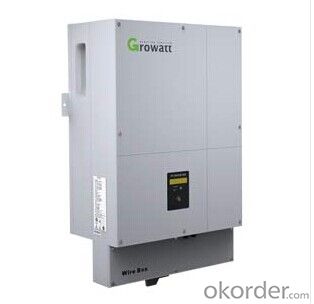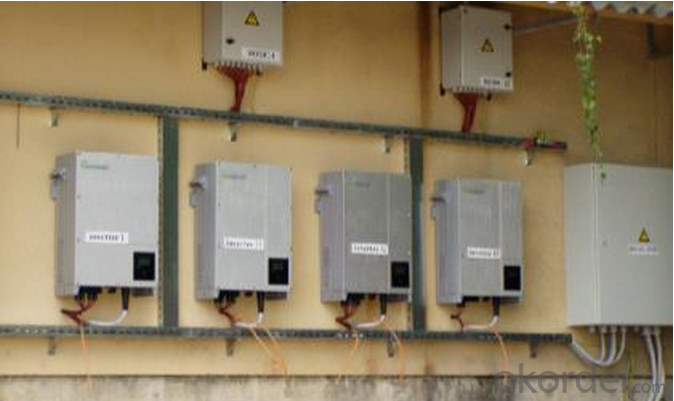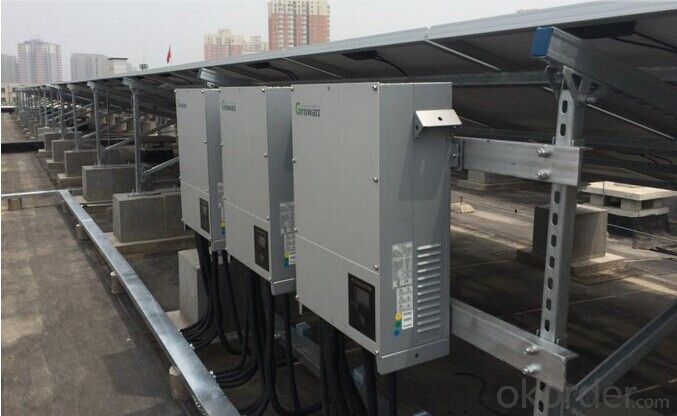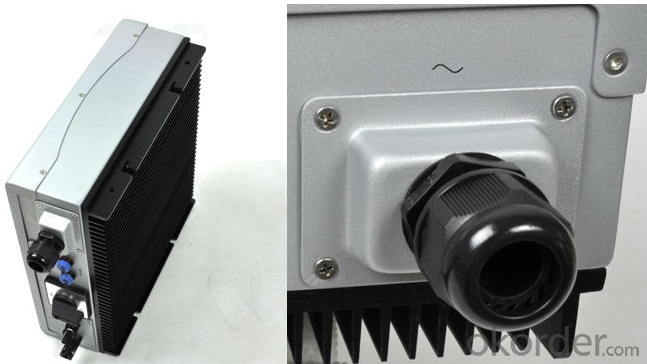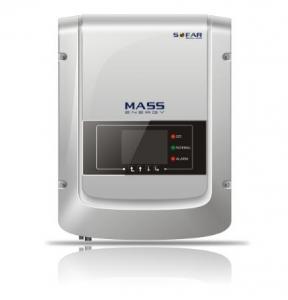Solar Inverter Company Grid Tied Solar Inverter 8000W-11000W Max 8300W TUV/UL/CSA/FCC
- Loading Port:
- Shekou
- Payment Terms:
- TT or LC
- Min Order Qty:
- 10 pc
- Supply Capability:
- 100000 pc/month
OKorder Service Pledge
OKorder Financial Service
You Might Also Like
Grid Tied Solar inverter 8000-11000kw
High efficiency of 97.8% delivery more energy
Integrated DC disconnect switch
Consistent and stable performance across entire input voltage and output power voltage
Intelligent temperature management
Power balancer for three-phase grid connection
Bluetooth/ RF technology/ Wi-Fi
Sound control, easy installation maintenance procedure
Newest generation IGBTs and advanced MPPT algorithms
8000TL-US | 9000TL-US | 10000TL-US | 11000TL-US | |
| Inputdata | ||||
| Max. DC power | 8300W | 9300W | 10350W | 11400W |
| Max. DC voltage | 600V | 600V | 600V | 600V |
| Start Voltage | 360V | 360V | 360V | 360V |
| DC nominal voltage | 345V@ 208VAC 379V@ 240VAC | 345V@ 208VAC 379V@ 240VAC | 345V@ 208VAC 379V@ 240VAC | 379V |
| PV voltage range | 300-600V@208V 345-600V@240V | 300-600V@208V 345-600V@240V | 300-600V@208V 345-600V@240V | 345-600V@208V 345-600V@240V |
| MPP voltage range(full load) | 300-480V@208V 345-480V@240V | 300-480V@208V 345-480V@240V | 300-480V@208V 345-480V@240V | 300-480V@208V 345-480V@240V |
| Max. input current/per string | 30A/16A | 33A/16A | 36A/16A | 35A/16A |
| Number of MPP trackers/ strings per MPP tracker | 1/4 | 1/4 | 1/4 | 1/4 |
| Efficiency | ||||
Max.efficiency | 97.8% | 97.8% | 97.8% | 97.5% |
| Rated AC output power | 8000W | 9000W | 10000W | 11000W |
| AC nominal voltage; range | 208V/240V;183-229V@208V,211-264V@240V | |||
| Max. output current | 44A@208V 38A@240V | 44A@208V 38A@240V | 44A@208V 38A@240V | 38A@240V |
| AC grid frequency; range | 60Hz; 59.3-60.5Hz | 60Hz; 59.3-60.5Hz | 60Hz; 59.3-60.5Hz | 60Hz; 59.3-60.5Hz |
| Power factor | 1 | 1 | 1 | 1 |
| THDI | <3% | <3% | <3% | <3% |
| Grid connection type | Two phase | Two phase | Two phase | Two phase |
| Features | ||||
Display Warranty: 10years/15years | LCD opt/opt/opt | LCD opt/opt/opt yes/opt | LCD yes/yes/ opt/opt/opt yes/opt | LCD opt/opt/opt yes/opt |
| Generaldata | ||||
Dimensions(W/H/D) in mm Weight Operating temperature range Noise emission(typical) Self-Consumption (night) Topology Cooling concept Environmental Protection rating Altitude Relative Humidity | 400/743/222 40KG -25℃ ... +60℃ <46db(a)< p=""> <0.5W Transformerless Smart cooling NEMA 3R 2000m withoutderating 0~100% | 400/743/222 40KG -25℃ ... +60℃ <46db(a)< p=""> <0.5W Transformerless Smart cooling NEMA 3R 2000m withoutderating 0~100% | 400/743/222 40KG -25℃ ... +60℃ <46db(a)< p=""> <0.5W Transformerless Smart cooling NEMA 3R 2000m withoutderating 0~100% | 400/743/222 40KG -25℃ ... +60℃ <46db(a)< p=""> <0.5W Transformerless Smart cooling NEMA 3R 2000m withoutderating 0~100% |
| Certificates and ApprovalsUL 1741, UL 1998, IEEE 1547, FCC part 15(Class B), CSA C22.2 No. 107.1 |
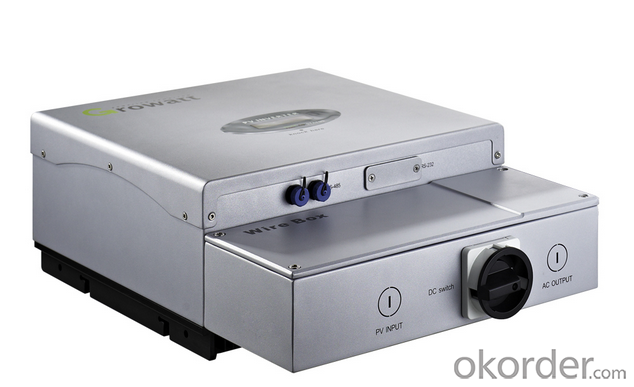
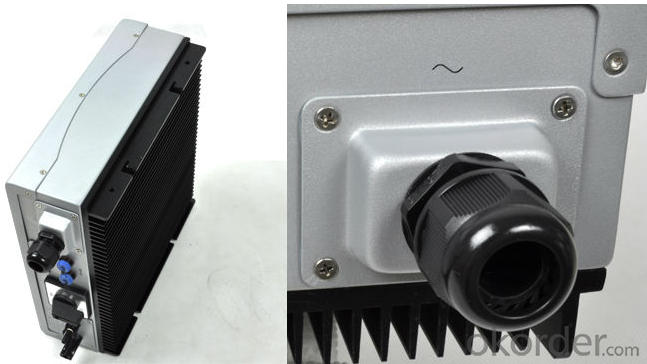
- Q: Can a solar inverter be used in regions with high levels of lightning activity?
- Yes, a solar inverter can be used in regions with high levels of lightning activity. However, it is important to ensure that the solar inverter is properly installed and equipped with surge protection devices to mitigate the risks associated with lightning strikes. Additionally, regular maintenance and inspections should be carried out to ensure the safety and functionality of the solar inverter in such regions.
- Q: What is the role of a solar inverter in preventing system downtime?
- The role of a solar inverter in preventing system downtime is crucial as it converts the direct current (DC) generated by solar panels into alternating current (AC) that can be used to power electrical devices. By regulating and stabilizing the electrical output, a solar inverter ensures that the system remains operational and prevents any potential disruptions or downtime. Additionally, modern solar inverters often come equipped with advanced features like monitoring capabilities, which allow for real-time identification and troubleshooting of any issues, further minimizing the risk of system downtime.
- Q: How do you monitor the performance of a solar inverter?
- To monitor the performance of a solar inverter, several methods can be employed. Firstly, real-time monitoring of key parameters such as voltage, current, and power output can be done using specialized monitoring devices or software. These tools provide a comprehensive overview of the inverter's performance, allowing for immediate identification of any issues or deviations from expected performance. Additionally, regular inspection and maintenance checks are crucial for performance monitoring. This involves visually inspecting the inverter for any physical damage or abnormalities, as well as checking the connections and wiring. Any signs of wear or malfunction should be promptly addressed to ensure optimal performance. Furthermore, data logging and analysis play a vital role in monitoring the inverter's performance over time. By collecting and analyzing historical data, trends and patterns can be identified, helping to detect potential issues or performance degradation. This can be done using software platforms that track and analyze the data from the inverter. Overall, a combination of real-time monitoring, regular inspections, and data analysis allows for effective performance monitoring of solar inverters, ensuring their optimal functioning and addressing any performance issues promptly.
- Q: What is the typical size and weight of a solar inverter?
- The typical size and weight of a solar inverter can vary depending on the capacity or power rating of the system. However, in general, residential solar inverters are compact and lightweight, with dimensions around 14-18 inches wide, 20-24 inches tall, and 6-8 inches deep. Their weight usually ranges between 25-50 pounds. Commercial or utility-scale solar inverters, on the other hand, can be much larger and heavier, often weighing hundreds or even thousands of pounds.
- Q: Can a solar inverter be used with a generator as a backup power source?
- Yes, a solar inverter can be used with a generator as a backup power source. The solar inverter can be connected to the generator's power output, allowing it to convert the generator's AC power into usable DC power for the solar panels. This enables the solar panels to continue generating electricity even when there is no sunlight, providing a reliable backup power supply.
- Q: How does a solar inverter handle variations in solar panel degradation over time?
- A solar inverter handles variations in solar panel degradation over time by continuously monitoring the power output of the solar panels and adjusting its operations accordingly. As solar panels degrade over time, their efficiency decreases, resulting in a decrease in power output. The inverter detects this decrease and adapts its operation to maximize the power conversion and maintain optimal performance. This ensures that the solar energy harvested from the panels is efficiently converted and utilized, despite variations in panel degradation.
- Q: Can a solar inverter be used with solar-powered electric vehicle charging stations?
- Yes, a solar inverter can be used with solar-powered electric vehicle charging stations. A solar inverter is necessary to convert the DC (direct current) power generated by solar panels into AC (alternating current) power that can be used by electric vehicle charging stations. This allows the solar power to be fed into the charging station and used to charge electric vehicles.
- Q: How does a solar inverter communicate with other devices?
- A solar inverter communicates with other devices through various communication protocols such as Wi-Fi, Bluetooth, Ethernet, or RS485. These protocols allow the inverter to connect and exchange information with devices such as monitoring systems, smart meters, or home automation systems. This communication enables real-time monitoring, data logging, and control of the solar energy system.
- Q: How does a solar inverter handle voltage sags and swells?
- A solar inverter handles voltage sags and swells by constantly monitoring the grid voltage. When a sag or swell is detected, it quickly adjusts its output voltage accordingly to ensure a stable and consistent flow of power to the connected solar panels. This helps protect the panels from potential damage and maintains optimal performance.
- Q: Can a solar inverter be used in areas with high electromagnetic radiation?
- Yes, a solar inverter can be used in areas with high electromagnetic radiation. However, it is important to note that the performance and reliability of the inverter may be affected by the presence of high electromagnetic radiation. High radiation levels can potentially cause electromagnetic interference (EMI) which may disrupt the functioning of the inverter and lead to reduced efficiency or even failure. Therefore, it is recommended to take necessary precautions such as proper grounding, shielding, and selecting inverters with robust EMI protection mechanisms when installing solar inverters in areas with high electromagnetic radiation. Additionally, it is advisable to consult with experts or manufacturers who can provide guidance on specific models of solar inverters that are designed to withstand and perform well in high electromagnetic radiation environments.
Send your message to us
Solar Inverter Company Grid Tied Solar Inverter 8000W-11000W Max 8300W TUV/UL/CSA/FCC
- Loading Port:
- Shekou
- Payment Terms:
- TT or LC
- Min Order Qty:
- 10 pc
- Supply Capability:
- 100000 pc/month
OKorder Service Pledge
OKorder Financial Service
Similar products
Hot products
Hot Searches
Related keywords





